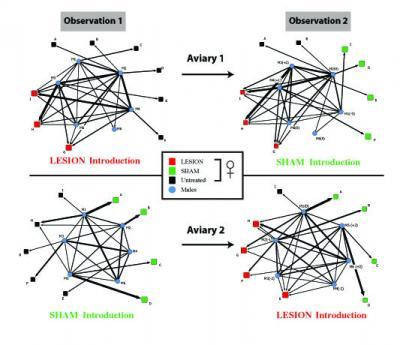Female cowbirds incapable of recognizing high-quality male songs can alter the behavior of flock-mates of either sex and disrupt overall social structure, according to research published May 1 in the open access journal PLOS ONE by Sarah Maguire and colleagues from the University of Pennsylvania.
Individual traits can impact a social network even in cowbirds, but the impact of changing individual behavior on the group as a whole can be difficult to elucidate. Here, the researchers inactivated female brain regions responsible for identifying high-quality mating songs. Though they did not record significant changes in the behavior of these birds individually, these 'tone-deaf' females had surprisingly strong effects on group dynamics in a mixed flock. Female birds with these regions inactivated received courtship songs from more males than normal females. As a result, males in the group changed their dominance status and courtship patterns, and the competitive behaviors of other females in the group were also affected. Aspects of behavior traditionally thought to be under male control, such as pair-bonding and mate guarding, were also influenced by the presence of these female birds in the flock. According to the authors, their results highlight the interconnected nature of an individual and its social environment, where neural systems which determine individual behavior can have a significant impact on social behaviors of the species.

Lesioned females destabilize the social network of mixed-sex flocks. Social network structure for each observation session in experiment 2. Lines represent directed singing interactions. Letters/numbers beside nodes represent individual identity, (females: squares males: circles). Vertical spacing of males represents relative dominance rank based on male-directed singing ratio. Numbers beside males in parenthesesrepresent change in dominance rank from the observation session before the one shown. Thickness of the line represents number of songs sung (largest line = 208 songs [aviary 2, lesioned introduction, M1 to A], smallest = 5 songs [multiple instances]). Arrows represent direction of singing interaction.
(Photo Credit: Maguire SE, Schmidt MF, White DJ (2013) Social Brains in Context: Lesions Targeted to the Song Control System in Female Cowbirds Affect Their SocialNetwork. PLoS ONE 8(5): e63239. doi:10.1371/journal.pone.0063239)
Maguire adds, "This work is the first to experimentally probe the structure of social networks by determining how individual circuits and behavior interact to form group stability."
Source: Public Library of Science